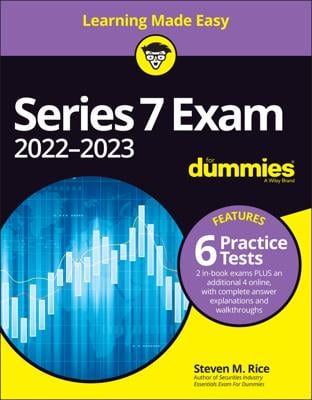The Series 7 asks you to calculate the numbers in a long margin account, which isn’t too difficult if you take it one step at a time. The basic long margin account formula is as follows:
LMV-DR=EQ
In other words, long market value minus debit balance equals equity.
Long market value . . .
The long market value (LMV) is the current market value of the securities purchased in a margin account. The LMV does not remain fixed; it changes as the market value of the securities changes. Certainly, if an investor is long (owns) the securities, he wants the LMV to increase.
When a customer purchases securities on margin, the margin call (the amount the customer has to come up with) is based on the LMV of the securities. With Regulation T set at 50 percent, an investor has to deposit 50 percent of the value of the securities purchased on margin.
. . . Minus debit balance . . .
DR is the debit balance (also called the debit record or debit register); it’s the amount of money that a customer owes a brokerage firm after purchasing securities on margin. The debit balance remains the same unless the customer pays back a portion of the amount borrowed by either selling securities in the account or by adding money to the account through dividends or payments.
Although you aren’t as likely to see a question about it on the Series 7 exam, the debit balance may be increased by interest charges imposed by the broker-dealer.
So, for example, if an investor purchases $20,000 worth of securities on margin, the debit balance would be $10,000. First you have to determine the margin call:
Margin call = LMV × Reg T
Margin call = $20,000 × 50% = $10,000
Then use the margin call and the following formula to determine the debit balance:
DR = LMV – margin call
DR = $20,000 – $10,000
. . . Equals equity
The equity (EQ) is the investor’s portion of the account. When an investor initially opens a margin account, the equity is equal to the margin call. However, the equity changes as the market value of the securities in the account changes. When an investor has more equity than the Regulation T requirement, he has excess; if an investor has less equity than the Regulation T requirement, his account is restricted.
When an investor has excess equity, he develops a line of credit known as a special memorandum account (SMA). Remember that the SMA is built into the equity, not an addition to it. When a customer uses or removes the SMA, the equity decreases and the debit balance increases.
Put it all together
The following question tests your ability to determine the debit balance in a long margin account.
Mr. Downey buys 1,000 shares of DEF common stock at $40 in a margin account. After Mr. Downey meets the margin call, what is the debit balance?
(A) $16,000
(B) $20,000
(C) $24,000
(D) $30,000
The correct answer is Choice (B). If the Series 7 gods are smiling down on you, you may actually get a question this straightforward. However, even if you don’t, you still need a starting point, and this is a good one. First, set up the equation:
Mr. Downey purchased $40,000 worth of stock (1,000 shares × $40 per share), so you need to enter $40,000 under the LMV. Next, figure out how much he needs to pay. Multiply the $40,000 × 50 percent, and you know that Mr. Downey has to come up with $20,000, which goes under the EQ. If the LMV is $40,000 and the EQ is $20,000, the DR has to be $20,000:
$40,000 – DR = $20,000
DR = $20,000

